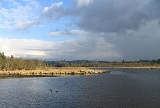
Burnaby Lake Regional Park
Encyclopedia
Burnaby Lake is a lake
located in Burnaby, British Columbia
and is the focal geographic feature and namesake of Burnaby Lake Regional Park. Occupying 3.11 square kilometres (768.5 acre) of land, and is home to a large variety of wildlife. At least 70 species of birds make the lake and surrounding areas their home, and about 214 species of birds visit the lake throughout the year. The park has been managed by the Metro Vancouver Parks Department since 1977.
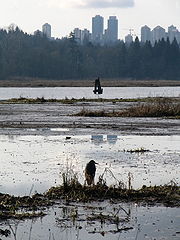 Burnaby Lake is a glacial lake
Burnaby Lake is a glacial lake
that formed about 12,000 years ago, at the end of the Pleistocene
ice age
.
The lake was named by Colonel Richard Moody
after his private secretary, Robert Burnaby
. According to a map and materials by Heritage Advisory Committee and Environment and Waste Management Committee of the City of Burnaby (1993), in March 1859 Colonel Moody began to survey the site of New Westminster as the capital city for the new Colony of British Columbia. He was particularly intrigued with the possibility that a fresh water lake existed north of the town. In a letter to Governor James Douglas
Moody wrote: "I now learn from the Indians that a lake does exist... Burnaby and Blake immediately volunteered their services to explore and also to trace the mouth to Burrard's Inlet
and to report generally on the countryside north of the town. After a considerable reluctance on account of the weather I have let them go with four days' provisions in light marching order, not even tents, two Indians, a Canadian Voyageur attached to Parson's survey party and my own trusty Corporal Brown R.E. They have been away now three days in the most deplorable weather. The rain was in torrents all last night and it is streaming down still in tropical torrents - nothing would gladden my eyes more than to see them back."
Robert Burnaby and the rest of the party did return safely and the official hydrographic chart produced in 1860 featured two discoveries: Burnaby Lake and the Brunette River
.
A number of sawmill
s were situated here in the late 19th century.
New Westminster Sub to the north (Formerly BN track). The Burnaby Lake Line of the British Columbia Electric Railway
's interurban
service from New Westminster to Vancouver
ran along the south side of the lake.
Still Creek
, Eagle Creek
, and Deer Lake
flow into Burnaby Lake, while the lake empties from the east to the Fraser River
through the Brunette River.
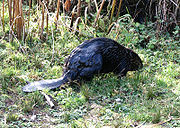
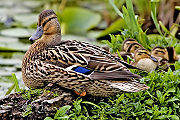 Burnaby Lake hosts over 400 varieties of plant
Burnaby Lake hosts over 400 varieties of plant
, bird
, fish
, mammal
, reptile
and amphibian
species. An exceptionally wide variety of birds frequent the area, including Great Blue Heron
s, bald eagle
s, osprey
, and the Green Heron
. Black bears once were common in the area. Burnaby Now Vegetation such as bladderwort
s, cattails, bulrush
es, and sedge
s are common around the area, with deciduous
trees around the edge of the marsh
es. Conifers occupy the areas furthest from the lake.
The lake is said to act as a settling pond for incoming pollutants from Still Creek
, thereby protecting the outflowing Brunette River. Large amounts of sediment, peat moss, decomposing plants, and water lilies make the lake unsuitable for swimming.
Because many storm sewers drain to the lake and the Brunette River, the Cariboo Dam at Brunette River controls the rate of water outflow to prevent flooding downstream during times of heavy rain.
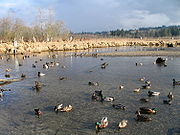 Birdwatching
Birdwatching
and hiking
are common, with 19 km of walking and hiking trails circling the entire lake. The Burnaby Equestrian
Centre is located here, with 6 km of horseback riding trails along the southern and eastern sides of the lake. Canoeing
, rowing
, and kayaking
is also popular, with the Burnaby Canoe and Kayak Club and the Burnaby Lake Rowing Club in the Burnaby Lake Pavilion at the west end of the lake.
The park is open from 8am to 9pm between the start of Daylight Saving Time
(second Sunday of March) to Labour Day
, and 8am to dusk for the rest of the year.
Lake
A lake is a body of relatively still fresh or salt water of considerable size, localized in a basin, that is surrounded by land. Lakes are inland and not part of the ocean and therefore are distinct from lagoons, and are larger and deeper than ponds. Lakes can be contrasted with rivers or streams,...
located in Burnaby, British Columbia
British Columbia
British Columbia is the westernmost of Canada's provinces and is known for its natural beauty, as reflected in its Latin motto, Splendor sine occasu . Its name was chosen by Queen Victoria in 1858...
and is the focal geographic feature and namesake of Burnaby Lake Regional Park. Occupying 3.11 square kilometres (768.5 acre) of land, and is home to a large variety of wildlife. At least 70 species of birds make the lake and surrounding areas their home, and about 214 species of birds visit the lake throughout the year. The park has been managed by the Metro Vancouver Parks Department since 1977.
History

Glacial lake
A glacial lake is a lake with origins in a melted glacier. Near the end of the last glacial period, roughly 10,000 years ago, glaciers began to retreat. A retreating glacier often left behind large deposits of ice in hollows between drumlins or hills. As the ice age ended, these melted to create...
that formed about 12,000 years ago, at the end of the Pleistocene
Pleistocene
The Pleistocene is the epoch from 2,588,000 to 11,700 years BP that spans the world's recent period of repeated glaciations. The name pleistocene is derived from the Greek and ....
ice age
Ice age
An ice age or, more precisely, glacial age, is a generic geological period of long-term reduction in the temperature of the Earth's surface and atmosphere, resulting in the presence or expansion of continental ice sheets, polar ice sheets and alpine glaciers...
.
The lake was named by Colonel Richard Moody
Richard Moody
Major-General Richard Clement Moody was a Lieutenant-Governor, and later Governor, of the Falkland Islands, and the first Lieutenant-Governor of the Colony of British Columbia. While serving under this post, he selected the site of the new capital, New Westminster...
after his private secretary, Robert Burnaby
Robert Burnaby
Robert Burnaby was amerchant, politician and civil servant in British Columbia. The city of Burnaby, British Columbia is named for him, as well as at least ten other urban and geographical features, including a mountain, a lake, a park, a Queen Charlotte Island and a street in Vancouver.Burnaby...
. According to a map and materials by Heritage Advisory Committee and Environment and Waste Management Committee of the City of Burnaby (1993), in March 1859 Colonel Moody began to survey the site of New Westminster as the capital city for the new Colony of British Columbia. He was particularly intrigued with the possibility that a fresh water lake existed north of the town. In a letter to Governor James Douglas
James Douglas (Governor)
Sir James Douglas KCB was a company fur-trader and a British colonial governor on Vancouver Island in northwestern North America, particularly in what is now British Columbia. Douglas worked for the North West Company, and later for the Hudson's Bay Company becoming a high-ranking company officer...
Moody wrote: "I now learn from the Indians that a lake does exist... Burnaby and Blake immediately volunteered their services to explore and also to trace the mouth to Burrard's Inlet
Burrard Inlet
Burrard Inlet is a relatively shallow-sided coastal fjord in southwestern British Columbia, Canada. Formed during the last Ice Age, it separates the City of Vancouver and the rest of the low-lying Burrard Peninsula from the slopes of the North Shore Mountains, home to the communities of West...
and to report generally on the countryside north of the town. After a considerable reluctance on account of the weather I have let them go with four days' provisions in light marching order, not even tents, two Indians, a Canadian Voyageur attached to Parson's survey party and my own trusty Corporal Brown R.E. They have been away now three days in the most deplorable weather. The rain was in torrents all last night and it is streaming down still in tropical torrents - nothing would gladden my eyes more than to see them back."
Robert Burnaby and the rest of the party did return safely and the official hydrographic chart produced in 1860 featured two discoveries: Burnaby Lake and the Brunette River
Brunette River
The Brunette River runs through East Burnaby and Coquitlam, flowing out of Burnaby Lake and to the Fraser River. According to a map and materials by Heritage Advisory Committee and Environment and Waste Management Committee of the City of Burnaby , the number of native campsites discovered on the...
.
A number of sawmill
Sawmill
A sawmill is a facility where logs are cut into boards.-Sawmill process:A sawmill's basic operation is much like those of hundreds of years ago; a log enters on one end and dimensional lumber exits on the other end....
s were situated here in the late 19th century.
Geography
The lake is situated to the east of Burnaby City Hall, and is bordered by Highway 1 to the south, and the CNCanadian National Railway
The Canadian National Railway Company is a Canadian Class I railway headquartered in Montreal, Quebec. CN's slogan is "North America's Railroad"....
New Westminster Sub to the north (Formerly BN track). The Burnaby Lake Line of the British Columbia Electric Railway
British Columbia Electric Railway
The British Columbia Electric Railway was a historic Canadian railway which operated in southwestern British Columbia.Originally the parent company, and later a division, of BC Electric, the BCER operated public transportation in southwestern British Columbia from its establishment in the...
's interurban
Interurban
An interurban, also called a radial railway in parts of Canada, is a type of electric passenger railroad; in short a hybrid between tram and train. Interurbans enjoyed widespread popularity in the first three decades of the twentieth century in North America. Until the early 1920s, most roads were...
service from New Westminster to Vancouver
Vancouver
Vancouver is a coastal seaport city on the mainland of British Columbia, Canada. It is the hub of Greater Vancouver, which, with over 2.3 million residents, is the third most populous metropolitan area in the country,...
ran along the south side of the lake.
Still Creek
Still Creek
Still Creek is a long stream flowing across Central Burnaby, British Columbia and into Burnaby Lake . Still Creek's path lies mainly through the industrial area which contributes to its high level of pollution, although through dedicated work of local volunteers the creek is slowly recovering.In...
, Eagle Creek
Eagle Creek (Burnaby)
Eagle Creek is one of the most important creeks in Burnaby, British Columbia, Canada. It begins on Burnaby Mountain where it is fed by a large watershed, runs through Montecito and the nearby Squint Lake, and eventually flows into Burnaby Lake.-Course:...
, and Deer Lake
Deer Lake (British Columbia)
Deer Lake is a lake in central Burnaby, British Columbia, Canada. Deer Lake is home to a wide variety of flora and fauna and features a number of walking trails...
flow into Burnaby Lake, while the lake empties from the east to the Fraser River
Fraser River
The Fraser River is the longest river within British Columbia, Canada, rising at Fraser Pass near Mount Robson in the Rocky Mountains and flowing for , into the Strait of Georgia at the city of Vancouver. It is the tenth longest river in Canada...
through the Brunette River.
Ecology


Plant
Plants are living organisms belonging to the kingdom Plantae. Precise definitions of the kingdom vary, but as the term is used here, plants include familiar organisms such as trees, flowers, herbs, bushes, grasses, vines, ferns, mosses, and green algae. The group is also called green plants or...
, bird
Bird
Birds are feathered, winged, bipedal, endothermic , egg-laying, vertebrate animals. Around 10,000 living species and 188 families makes them the most speciose class of tetrapod vertebrates. They inhabit ecosystems across the globe, from the Arctic to the Antarctic. Extant birds range in size from...
, fish
Fish
Fish are a paraphyletic group of organisms that consist of all gill-bearing aquatic vertebrate animals that lack limbs with digits. Included in this definition are the living hagfish, lampreys, and cartilaginous and bony fish, as well as various extinct related groups...
, mammal
Mammal
Mammals are members of a class of air-breathing vertebrate animals characterised by the possession of endothermy, hair, three middle ear bones, and mammary glands functional in mothers with young...
, reptile
Reptile
Reptiles are members of a class of air-breathing, ectothermic vertebrates which are characterized by laying shelled eggs , and having skin covered in scales and/or scutes. They are tetrapods, either having four limbs or being descended from four-limbed ancestors...
and amphibian
Amphibian
Amphibians , are a class of vertebrate animals including animals such as toads, frogs, caecilians, and salamanders. They are characterized as non-amniote ectothermic tetrapods...
species. An exceptionally wide variety of birds frequent the area, including Great Blue Heron
Great Blue Heron
The Great Blue Heron is a large wading bird in the heron family Ardeidae, common near the shores of open water and in wetlands over most of North and Central America as well as the West Indies and the Galápagos Islands. It is a rare vagrant to Europe, with records from Spain, the Azores and England...
s, bald eagle
Bald Eagle
The Bald Eagle is a bird of prey found in North America. It is the national bird and symbol of the United States of America. This sea eagle has two known sub-species and forms a species pair with the White-tailed Eagle...
s, osprey
Osprey
The Osprey , sometimes known as the sea hawk or fish eagle, is a diurnal, fish-eating bird of prey. It is a large raptor, reaching more than in length and across the wings...
, and the Green Heron
Green Heron
The Green Heron is a small heron of North and Central America. It was long considered conspecific with its sister species the Striated Heron , and together they were called "Green-backed Heron"...
. Black bears once were common in the area. Burnaby Now Vegetation such as bladderwort
Bladderwort
Utricularia, commonly and collectively called the bladderworts, is a genus of carnivorous plants consisting of approximately 233 species . They occur in fresh water and wet soil as terrestrial or aquatic species across every continent except Antarctica...
s, cattails, bulrush
Bulrush
-Wetland plants:* Bolboschoenus, a genus in the sedge family * Cyperus, a genus in the sedge family * Scirpus, a genus in the sedge family * Schoenoplectus, a genus in the sedge family...
es, and sedge
Cyperaceae
Cyperaceae are a family of monocotyledonous graminoid flowering plants known as sedges, which superficially resemble grasses or rushes. The family is large, with some 5,500 species described in about 109 genera. These species are widely distributed, with the centers of diversity for the group...
s are common around the area, with deciduous
Deciduous
Deciduous means "falling off at maturity" or "tending to fall off", and is typically used in reference to trees or shrubs that lose their leaves seasonally, and to the shedding of other plant structures such as petals after flowering or fruit when ripe...
trees around the edge of the marsh
Marsh
In geography, a marsh, or morass, is a type of wetland that is subject to frequent or continuous flood. Typically the water is shallow and features grasses, rushes, reeds, typhas, sedges, other herbaceous plants, and moss....
es. Conifers occupy the areas furthest from the lake.
The lake is said to act as a settling pond for incoming pollutants from Still Creek
Still Creek
Still Creek is a long stream flowing across Central Burnaby, British Columbia and into Burnaby Lake . Still Creek's path lies mainly through the industrial area which contributes to its high level of pollution, although through dedicated work of local volunteers the creek is slowly recovering.In...
, thereby protecting the outflowing Brunette River. Large amounts of sediment, peat moss, decomposing plants, and water lilies make the lake unsuitable for swimming.
Because many storm sewers drain to the lake and the Brunette River, the Cariboo Dam at Brunette River controls the rate of water outflow to prevent flooding downstream during times of heavy rain.
Activities

Birdwatching
Birdwatching or birding is the observation of birds as a recreational activity. It can be done with the naked eye, through a visual enhancement device like binoculars and telescopes, or by listening for bird sounds. Birding often involves a significant auditory component, as many bird species are...
and hiking
Hiking
Hiking is an outdoor activity which consists of walking in natural environments, often in mountainous or other scenic terrain. People often hike on hiking trails. It is such a popular activity that there are numerous hiking organizations worldwide. The health benefits of different types of hiking...
are common, with 19 km of walking and hiking trails circling the entire lake. The Burnaby Equestrian
Equestrianism
Equestrianism more often known as riding, horseback riding or horse riding refers to the skill of riding, driving, or vaulting with horses...
Centre is located here, with 6 km of horseback riding trails along the southern and eastern sides of the lake. Canoeing
Canoeing
Canoeing is an outdoor activity that involves a special kind of canoe.Open canoes may be 'poled' , sailed, 'lined and tracked' or even 'gunnel-bobbed'....
, rowing
Watercraft rowing
Watercraft rowing is the act of propelling a boat using the motion of oars in the water. The difference between paddling and rowing is that with rowing the oars have a mechanical connection with the boat whereas with paddling the paddles are hand-held with no mechanical connection.This article...
, and kayaking
Kayaking
Kayaking is the use of a kayak for moving across water. Kayaking and canoeing are also known as paddling. Kayaking is distinguished from canoeing by the sitting position of the paddler and the number of blades on the paddle...
is also popular, with the Burnaby Canoe and Kayak Club and the Burnaby Lake Rowing Club in the Burnaby Lake Pavilion at the west end of the lake.
Other attractions
- Burnaby Lake Nature House
- Butterfly garden
- Piper Spit pier
- Burnaby Sports Complex
- Wildlife Rescue Association
The park is open from 8am to 9pm between the start of Daylight Saving Time
Daylight saving time
Daylight saving time —also summer time in several countries including in British English and European official terminology —is the practice of temporarily advancing clocks during the summertime so that afternoons have more daylight and mornings have less...
(second Sunday of March) to Labour Day
Labour Day
Labour Day or Labor Day is an annual holiday to celebrate the economic and social achievements of workers. Labour Day has its origins in the labour union movement, specifically the eight-hour day movement, which advocated eight hours for work, eight hours for recreation, and eight hours for...
, and 8am to dusk for the rest of the year.

